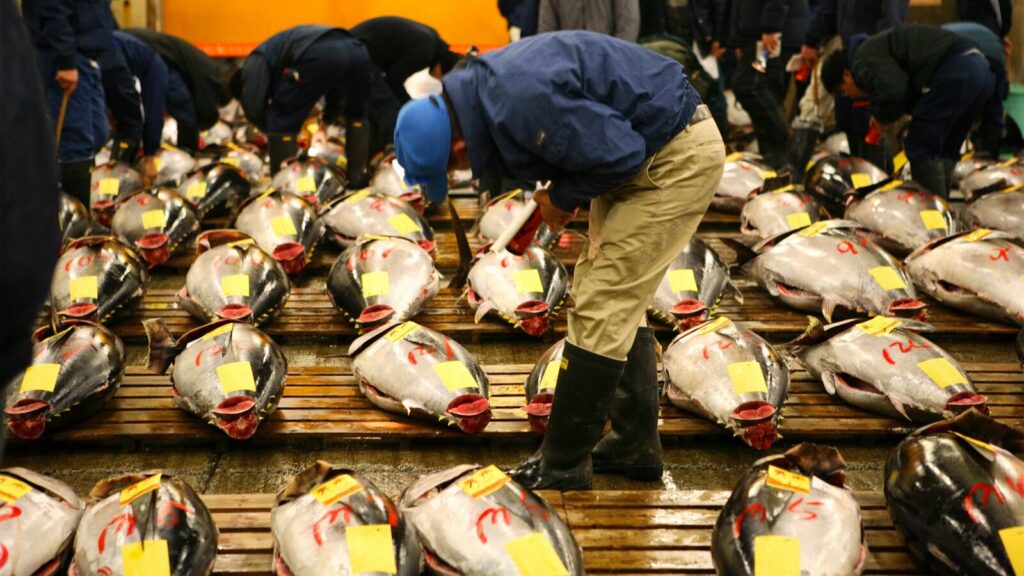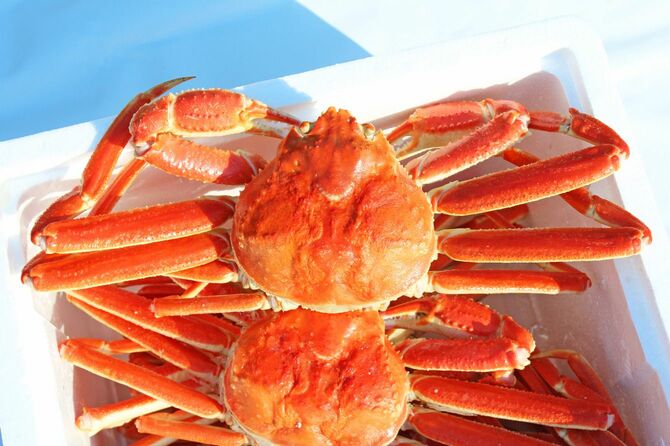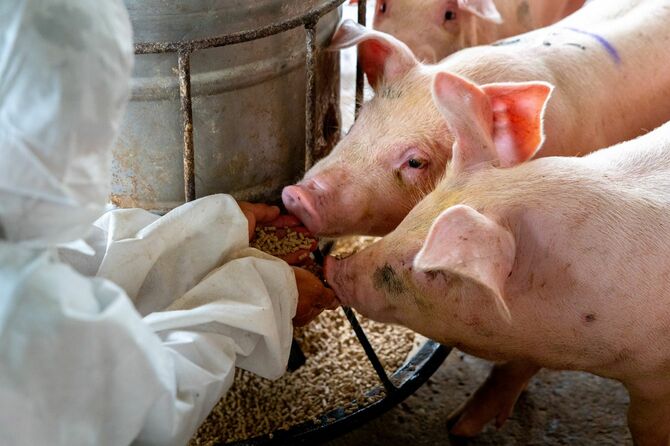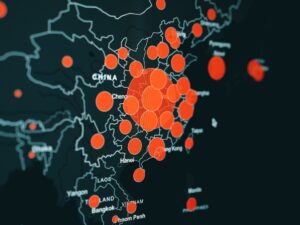The price of foodstuffs continues to rise. Takanori Sakaguchi, a procurement and purchasing consultant, says, “Overseas buyers are purchasing at higher prices than Japanese buyers. We should face the reality that Japan’s purchasing power for food is declining,” he says.

Chinese buyers” buying tuna
At the first tuna auction at the beginning of the year, a tuna from Oma, Aomori, was priced at 36,040,000 yen at the Toyosu market in 2023. The successful bidders were the ONODERA GROUP, which operates Ginza ONODERA, and the seafood brokerage Yamayuki. The news also reported the appearance of Kiyoshi Kimura, president of Sushi Zammai, as a regular customer of the restaurant.
Meanwhile, the presence of Chinese buyers is growing.
The Port of Yaizu, which is known to have the largest amount of fish landed in Japan, is overrun by Chinese buyers. Of course, roving Chinese buyers do not necessarily engage in illegal activities. Among the Chinese, tuna dismantling shows are popular. Chinese buyers, mainly wealthy Chinese, have come to Japan in search of high quality tuna because they have “discovered the deliciousness of tuna” from their trips to Japan and other experiences.
Chinese buyers “demand large quantities” and “pay well. This makes it impossible for the brokers not to sell. Chinese buyers are Chinese buyers, and it is economically rational for them to purchase up to the maximum amount demanded by Chinese consumers. While the world’s per capita consumption of seafood has doubled in 50 years, in China it has grown a whopping 9 times. Japan’s per capita seafood consumption is lower than it was 50 years ago, and it is now being outpaced by China. Furthermore, Japan is being edged out by China in per capita consumption, but the populations of the two countries are completely different.
Demand is rising around the world, causing many “buyers to lose out.
According to the Fisheries Agency, domestic production of tuna between 1988 and 2020 dropped from 260,000 tons to 110,000 tons. Imports have also declined from 460,000 tons to 280,000 tons (Ministry of Agriculture, Forestry and Fisheries “Fishery and Aquaculture Production Statistics,” Ministry of Finance “Trade Statistics”).
News broke that bento box stores had to change the fish they use because they could not stock tuna. Not only tuna, but all fish species sold by fishermen to wholesalers generally increased in price in 2022 from the previous year. This also extends to popular fish. This is not only because of high-end fish such as tuna, but also because of the weak yen, declining catches, and soaring oil prices, as well as the loss of buying power to other countries.
It is still fresh in our minds that a major conveyor-belt sushi chain announced a price revision in 2022. The price of snow crab has also nearly doubled in five years. More and more people around the world are eating it. Demand has skyrocketed, and Japan has not been able to bid at a high price. As a result, Japan’s imports have decreased by about 20% in the 10 years to 2022, and the value has increased by about 2.2 times. It is not only fisheries resources. Beef is also often “outbid” by China.

China’s beef imports are increasing dramatically: from a little over 500,000 tons in 2016 to 2.33 million tons in 2021. In the market, Asian countries such as Taiwan and South Korea are fighting to buy beef. The situation of unavailability in Japan was called “meat shock.
Other countries are buying at more than 30% higher prices than Japan.
Some Japanese trading companies said that even if they tried to procure the meat that other countries are competing to buy, “It is too expensive, and even if we buy it, we cannot sell it at that price, so we cannot make a profit. Global suppliers also sometimes haggled with Japanese firms because China would buy at a higher price. However, even if Japan did not buy, China would. In fact, beef exports from Japan to other countries are increasing rapidly.
Buyers, also mainly from China, purchase beef at prices 30% higher than those of Japanese buyers. It can be said that the situation where Japanese products are bought at a higher price is gratifying, but is it right to be happy about it? Lamb, which is becoming popular for its low sugar content, has also been affected by the growth of Chinese hot pot consumption. Japan procures 30% of its mutton from New Zealand, which also exports a lot to China. China boasts strong demand. Japan’s imports from that country temporarily declined from 2020 to 2021.
The price of young chicken meat from Brazil has also skyrocketed. The reason is that other countries are procuring at higher prices and Japan is losing out. Until a few years ago, no other country would pay more than Japan. Many Brazilian poultry farmers sell their chicken meat through trading companies. This is because it is difficult for poultry farmers to sell to a country where the language is different from theirs, and they have to take care of all the trade business.
Farmed fish are also greatly affected.
Recently, trading companies have been asked to negotiate a price increase, saying that the price that China buys from them is higher than the price that Japan buys from them. When Japan refuses to negotiate, they are said to turn to China. This, too, cannot be blamed on the poultry farmers due to economic rationality.
In Japan, instead of young chicken meat, parent chicken meat, which has been ignored until now, is now used for minced meat. Even so, Japan has been losing out on purchases in many cases. Other countries had not chosen Brazilian products, but the Ukrainian war caused a total shortage as they switched from Ukraine to Brazil. As it happened, there was also bird flu in 2022, and manufacturers of chicken meal ingredients had to stop production due to supply shortages.
These meat products have even taken on the tinge of a procurement war. Despite the fact that there are some religions that shun meat, according to data from the Food and Agriculture Organization of the United Nations, there is a generally positive correlation between GDP per capita and demand for meat. As long as emerging economies continue to grow, there will be competition for meat.
One might think that farmed fish would be unaffected by other countries. However, what has occurred in recent years has caused farmers to moan and groan. The price of fishmeal in their feed has been rising.
They also depend on China for fertilizer and livestock feed.
The fishmeal is made from Peruvian anchovies, which China was procuring at a high price. China accounts for the overwhelming majority of the world’s pork consumption, and fishmeal is mainly for pig farming, not aquaculture.

Chinese suppliers secured the quantity of fishmeal by placing pre-orders at high prices, no matter how high the price of fishmeal rose. For Japan, this had a significant impact because fishmeal accounts for more than 60% of the cost of aquaculture. Fish farmers are researching how to avoid using fishmeal, and are continuing to feed fish with soybean oil cake and other ingredients through trial and error.
The Fisheries Agency is also planning to develop new feed ingredients. The Fisheries Agency is also planning to develop new feed ingredients. The efforts of those involved in providing subsidies were probably considerable, but fishmeal had been adopted until then because of its low cost. There are many issues to be addressed, including the low cost of alternatives and a stable procurement system.
Furthermore, Japan relies on imports not only for the food it puts on its tables, but also for fertilizers for its crops and livestock feed. Among fertilizers, potassium chloride was imported in large quantities from Russia and Belarus. It is no secret that these have been stagnant. Urea comes from China and Malaysia, and ammonium phosphate from China. Although we are able to procure from China, the future stability of this supply is doubtful.
The problem cannot be solved without ministerial action.
In 2022, the Vice Minister of Agriculture, Forestry, and Fisheries went to Morocco in a hurry to ask for the supply of ammonium phosphate. According to the Ministry of Agriculture, Forestry, and Fisheries, he “stated that he would like to cooperate in ensuring a stable supply. Although we think this response is strong, there is so much competition for food and fertilizer raw materials that the top management needs to move.
While the earth’s harvest is increasing, it is not infinite, and population growth is also significant. Extreme weather also accelerates the competition for food. In fact, international prices for some types of fertilizers have increased several times over the past few years. Furthermore, the majority of nitrogen fertilizers are made from ammonia, and as if spurred on by this, factories in various countries are experiencing instability due to soaring prices of natural gas and other resources used as fuel. In Africa, more and more farmers are even reducing fertilizer inputs.
As is the case with both crops and livestock, it is up to luck whether the rising cost of raising cattle can be recovered. For example, it takes several years to raise Wagyu cattle before they can be shipped. This is because even if there is a sharp rise in the price of feed during the process, it has nothing to do with the market price at the time of shipment, so there is a possibility of a loss.
Postwar Japan’s Excess of Rice and Dependence on Wheat
The well-known figure for food self-sufficiency on a calorie basis is 38%. While rice, the staple food, is doing well at 75%, wheat and livestock products account for only 17% and 16%, respectively. Not only the calorie base, but also the production value base is declining.
Japan was originally 67% self-sufficient in wheat in 1930, when records are kept. Shortly after the war, it was still above 40%. However, at the request of the U.S., Japan took on excess wheat stocks and adopted bread for school lunches. Next came an excess of rice, and wheat became increasingly dependent on the rest of the world.
Russia and Ukraine accounted for 30% of world exports of wheat. The global price spike was natural, as supplies from the two countries were reduced by war or by political reasons. Every country is affected by world prices. U.S. and Canadian production also rose. The government is trying to halt the decline in farmers, utilize domestic compost, subsidize domestic wheat production, etc. It is trying to increase food self-sufficiency to 45% by 2030, but there is no reason for optimism.
Another important grain is corn, which has soared from just over $100 a ton in 2020-2021 to about $250 a ton in early 2023. China is increasing its imports from the United States. This is the result of the economic war between the U.S. and China, in which China promised the U.S. increased imports of U.S. products after negotiations.
It is rather amazing that food self-sufficiency has remained flat.
China became dependent on the US. Then the war in Ukraine broke out and the wrangling began in earnest.
Ukraine accounted for just over 10% of the world’s corn exports. The war, with the food-producing regions as the victimized areas, caused the market to soar. In addition, Ukrainian farmers were hurt by the fact that they did not have air conditioning facilities to store grain for long periods of time. There was also bad weather in many parts of the world, and the demand for biofuels made from grain increased. In addition, Japan experienced procurement difficulties.
Twenty-four years have passed since 1999, when the Basic Act on Food, Agriculture, and Rural Areas was formulated in Japan. The law was aimed at ensuring a stable supply of food. However, since then, the food self-sufficiency rate has remained flat and has not increased. However, it has done well to stay flat.
There are 1.23 million people engaged in agriculture, most of them over the age of 60. In addition, there are those who have chosen to close their businesses. Naturally, both farmland and total output are decreasing. In recent years, farmers have been plunged into a crisis situation due to the soaring prices of production materials. In fact, bankruptcies of agriculture-related companies in 2020 and 2022, when the Corona disaster began, are the highest in the past 20 years. Fertilizers and feedstuffs from overseas have skyrocketed in price. Moreover, since they cannot be bought at high prices in Japan, farmers have no choice but to bear the costs themselves.
Japan used to be the world’s largest importer of agricultural, forestry, and fishery products…
During the high-growth period, Japan was literally growing, so it was able to procure food even as prices rose. But its relative position has declined. Of course, it was not for nothing. Japan had experienced World War II, the U.S. embargo, and the “soybean shock” of 1973, and had begun to take precautionary measures. It also expanded its procurement sources and financial assistance to other countries. Today, however, Japan’s relative purchasing power for food has declined.
Suppose a product is purchased for 100 yen and sold for 200 yen. The purchase cost is 50%. Suppose that due to growth and inflation in other countries, the purchase price of the food becomes 200 yen. If your country grows and you can sell the product at 400 yen, double the purchase price, there is no problem. However, this is not the case in Japan, and the “ability to procure” has declined.
In 1998, Japan was the world’s largest importer of agricultural, forestry, and fishery products at $53.3 billion. Japan was the most important customer and everyone was looking to Japan. However, due to rapid population growth and economic growth, China topped the list with $125.1 billion in 2021. Furthermore, China dominates the world’s food consumption, with vegetables and pork accounting for around 50% of global food consumption, and fruits and grains around 25%.
Related articles
Takanori Sakaguchi







